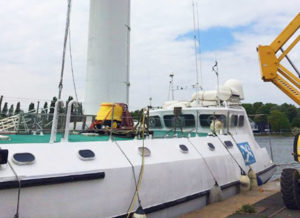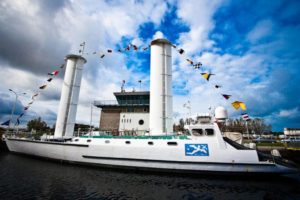 Since 1985, Alcyone has been The Cousteau Society’s expedition ship. Caen, France, is her home port. Alcyone’s success celebrates not just the wedding of hydrodynamics and aerodynamics, it also marks the entry of electronics and computers into the maritime world.
Since 1985, Alcyone has been The Cousteau Society’s expedition ship. Caen, France, is her home port. Alcyone’s success celebrates not just the wedding of hydrodynamics and aerodynamics, it also marks the entry of electronics and computers into the maritime world.
Beginning in 1980, Captain Cousteau’s teams, in France and in the US, began refining a concept of economical propulsion for ships using the wind as a supplementary energy source. This revolutionary system, the Turbosail™ allows for fossil-fuel savings of up to 35 percent. The ship’s designers sought a compromise between a monohull and a catamaran, which would be perfectly adapted to the mixed propulsion system
Captain Jacques-Yves Cousteau realized his dream of capturing the wind to propel a ship when, in 1985, from La Rochelle, France, Alcyone, called the ” Daughter of the Wind “, crossed the Atlantic and arrived triumphantly in the port of New York.
Her missions have taken her all the way down the Americas to Cape Horn, then along the Pacific coast to the Sea of Cortez (Mexico) in 1986, where the crew watched a school of fin whales feeding, then elephant seals being tagged in the Channel Islands (California) in 1987 and, in 1988, attempted to follow the migration of humpback whales from the Hawaiian islands to Alaska. In 1989, Alcyone arrived in Papua New Guinea.
In 1990, she studied Australia’s great white sharks, explored Madagascar in 1994, and met more white sharks off Namibia in 1996. In 1998, she documented the status of the enclosed Caspian Sea; it was the first time in forty years that a foreign vessel was authorized to enter the sea. She traveled to her US home in Virginia for much-needed maintenance on her Turbosails, then left for the St. Lawrence River in 2000 to observe conditions of marine mammal exploitation. In 2001, Alcyone returned to her home port, La Rochelle, for a complete overhaul, including new engines. The Alcyone home port is now Concarneau, Brittany, France.

Inside the ship, a servosystem runs the Turbosails completely automatically. Comprised essentially of a multitask computer and a graphic interface, the central system manages and steers 21 electronic, electromagnetic and hydraulic controls based on data collected by 43 analog or digital sensors. Equipped with a DVonSat system, Alcyone can transmit images instantly by satellite all around the world to the Internet and television. Alcyone prefigures the navigation of tomorrow.
Saving and protecting marine life for present and future generations since 1973
©2024 The Cousteau Society.
All rights reserved.